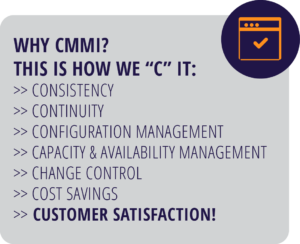By Brian Ayala & Laura New
Ever wonder what it takes to succeed in a CMMI appraisal? Do you ask yourself, “Where do companies even begin?” Do you question whether your company could handle the work?
The MIL Corporation had many of those same questions when we began looking at CMMI almost a decade ago.  Today, though, MIL is truly a seasoned “Quality Warrior.” In January, MIL renewed its Level 3 rating for the CMMI-Development model and its Level 2 rating for CMMI-Services model. Just two months ago, MIL also led the effort to achieve a Level 2 rating for the CMMI-Development model for the U.S. Department of State.
Today, though, MIL is truly a seasoned “Quality Warrior.” In January, MIL renewed its Level 3 rating for the CMMI-Development model and its Level 2 rating for CMMI-Services model. Just two months ago, MIL also led the effort to achieve a Level 2 rating for the CMMI-Development model for the U.S. Department of State.
During our own appraisals, work products for two development projects were reviewed against 132 different specific practices and 12 generic practices covering 17 different process areas. MIL also presented two services for review, which were each measured against 48 specific practices and 10 generic practices covering 7 different process areas. Overall, the evaluations consisted of an exhaustive mix of documentation review (over 200 separate documents!) and 19 interviews.
After rallying behind these critical initiatives, MIL’s quality experts recently sat down together again to document their experience with CMMI and to share what has led to their successes. So, what are the major takeaways? Read on to find out!
MIL’s Top 5 Keys to CMMI Appraisal Success
Understand the Model
Our most important recommendation for you is to understand the model. Read the book (but don’t stop there!) Study tips online. Take a class with your managers or coworkers. Talk to others who are knowledgeable about CMMI. Ask questions (lots of questions!). The more you know, and the more your organization knows, the better equipped you will be.
Determine Where You Are Now
Different companies may handle this step in different ways, but we suggest you first document your existing processes and any new processes you know you want to implement. Then, perform a gap analysis against the model with a CMMI expert. Next, update your processes to cover the identified gaps. To some, it may seem counterintuitive to document process you know you are going to change. But remember that CMMI is all about process improvement. You should expect your processes to change (again and again and again). By documenting your existing process first, you are setting a baseline for future maturity.
Set Realistic Goals
Achieving a CMMI rating takes time. Our recent assessment included more than 200 separate documents (literally, thousands of pages!) produced by dozens of team members. You can break down big goals into smaller, more discrete tasks with specific end dates. Your workgroup should meet together to hold everyone accountable, to share in the successes (expect many), and to address areas of concern (yes, expect those too!).
Identify Logical Resources
Take a look at your organization. Do you have employees who are well suited for certain tasks? Maybe you have several employees who love to write. Those individuals could perhaps carry much of your documentation work and establish your templates. Do you have other employees who love schedules? Make them your team that oversees deadlines. Do others thrive in a testing role? Organize a group to test your processes against the model. You do not have to involve everyone in creating your process documents; however, often, people buy into a process when they are involved in creating it.
Collaborate with a Certified Lead Appraiser
Regardless of your company’s processes and experience with CMMI, a CMMI Certified Lead Appraiser can offer valuable insight into the model and your approach. Work with your appraisers early and frequently, ask questions along the way, and listen to their advice whenever you can. Appraisers see the model used in countless ways and their independent perspective can simplify and streamline your work substantially.
You may ask yourself, is all of the work worth it? We’re here to say yeah, it’s worth it!
Blog Name Results
The masses have spoken, and the masses like simplicity. MIL’s blog will remain named…Blog. Thanks for your participation!
